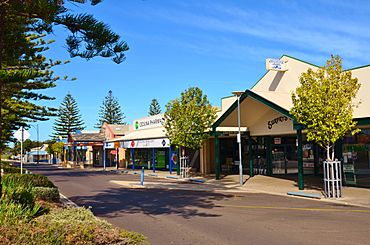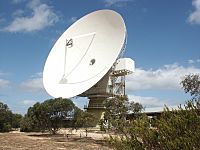Ceduna, South Australia facts for kids
Quick facts for kids CedunaSouth Australia |
|||||||||||||||
|---|---|---|---|---|---|---|---|---|---|---|---|---|---|---|---|

Poynton Street, the main street of Ceduna
|
|||||||||||||||
| Established | 1898 | ||||||||||||||
| Postcode(s) | 5690 | ||||||||||||||
| Location |
|
||||||||||||||
| LGA(s) | District Council of Ceduna | ||||||||||||||
| State electorate(s) | Flinders | ||||||||||||||
| Federal Division(s) | Grey | ||||||||||||||
|
|||||||||||||||
|
|||||||||||||||
Ceduna is a town in South Australia. It is located on the coast, on the shores of Murat Bay, west of the Eyre Peninsula. Ceduna is about 786 kilometres (488 miles) northwest of Adelaide. The nearby port of Thevenard is just 3 kilometres (1.9 miles) to the west.
The name Ceduna comes from a local Aboriginal Wirangu word. It is believed to mean "a place to sit down and rest." Today, Ceduna is an important fishing port and a railway hub.
Contents
History of Ceduna
Early Inhabitants and Explorers
The Wirangu people were the first to live in the area where Ceduna is now. About 7,500 to 18,000 years ago, rising sea levels changed the coast. This caused big shifts in where people lived.
In 1802, explorer Matthew Flinders visited the coast. He named places like Denial Bay and Smoky Bay. He was hoping to find a river that went inland, but he didn't. That's why he called it Denial Bay. Later, French explorer Nicolas Baudin visited Murat Bay. He named it after Joachim Murat. He also named Cape Thevenard and Decres Bay.
The first Europeans to explore the land around Ceduna were John Hill and Samuel Stephens in 1839. They said the bay was good, but the land was "waterless." This made Europeans less interested in settling there for a while.
Settlement and Growth
In the 1850s, there was a whaling station on nearby St Peter Island. This was before the town was officially settled.
In 1887, farmers looked at the land between Streaky Bay and Western Australia. They thought it was good for farming. So, in 1889, the government started surveying the land. The town of Ceduna was officially created in June 1901. For many years, locals called it Murat Bay. But when the railway came in 1915 and named its stop Ceduna, the town's name stuck. The Ceduna Jetty was built in 1902.
In 1928, the Tod Water pipeline was opened. This helped bring water to the area.
Modern Developments
Ceduna once had a big satellite communication centre. It was run by the Overseas Telecommunications Commission. This centre was a major employer in the town. By 1984, nearly half of Australia's international phone calls went through Ceduna. Now, the large dish is used as a radio telescope by the University of Tasmania.
On December 4, 2002, Ceduna became famous when a solar eclipse passed right over the town. Even though it was partly cloudy nearby, the sky over Ceduna was clear for the eclipse.
In 2011, a new Ceduna Hospital was opened. This was part of a big project to improve healthcare in the area.
In 2010, the world's largest mineral sands mine opened. It is called the Jacinth-Ambrosia Mine. It is about 200 kilometres (124 miles) northwest of Ceduna. Ceduna helps support this mine.
About Ceduna Today
Ceduna is the last big town you reach before crossing the Nullarbor Plain from east to west. It is on Murat Bay, which has sandy coves and sheltered areas. This makes it a great place for beach holidays. The foreshore has many Norfolk Island pine trees. There is also a jetty where you can walk, fish, and launch small boats.
Population and People
According to the 2021 census, about 1,959 people live in Ceduna. About 26.4% of the people are Aboriginal and Torres Strait Islander. Most people (79.2%) were born in Australia, and 82.1% speak only English at home.
Ceduna is a service centre for many Aboriginal communities in the area. The Far West Languages Centre (FWLC) was started in 2006. It helps keep three local endangered languages alive: Wirangu, Mirning, and Kokatha.
Education in Ceduna
Ceduna has two schools: Ceduna Area School (CAS) and Crossways Lutheran School. Ceduna Area School has about 600 students from Reception to Year 12. About 25% of these students are Indigenous. Crossways Lutheran School has around 150 students from Reception to Year 10. About 80% of their students are Indigenous.
Economic Activities
Ceduna is important for the Iluka Resources mineral sands mine. The town provides services for the mine's operations. A new housing area called Ceduna Waters is also growing. It is about 3 kilometres (1.9 miles) from the town centre. This development helps provide homes for workers, including those from the mine.
The port of Thevenard, near Ceduna, is a busy deep-sea port. It exports grain, salt, mineral sand, and gypsum. These products are all found in the local area.
Pacific oyster farming is a big industry in Ceduna. Deep-sea fishing and tuna fishing have also grown in the region.
Scientific Research
Ceduna has a radio telescope that is part of Australia's CSIRO network. This large dish was given to the University of Tasmania in 1996. It is still used today for studying space.
Ceduna is also a centre for research on southern bluefin tuna. Its location is perfect for collecting data about these fish.
Cultural Events and Tourism
Ceduna's yearly Oysterfest is a very popular event. It happens on the South Australia Labour Day long weekend. The festival started in 1991 and attracts over 6,000 people. It celebrates the oyster industry in the clean waters of the far-west coast. There are many activities, including live concerts, cooking shows, and a street parade. The festival ends with fireworks.
Ceduna is known as the gateway to the Nullarbor Plain. It is on the National Highway, which sees over 240,000 vehicles each year. The town has several places to stay, like caravan parks and motels. Tourism is popular because of the nearby conservation parks, beautiful beaches, and great fishing spots.
Environment and Climate
Climate in Ceduna
Ceduna has a semi-arid climate. This means it has warm, dry summers. Springs and autumns are mild to warm and dry. Winters are mild and relatively dry. June is usually the wettest month. The average rainfall each year is just under 300mm (11.8 inches) near the coast. This amount decreases as you go further inland.
Goyder's Line starts near Ceduna. This is an imaginary line that shows where there is usually enough rainfall for farming. On December 19, 2019, Ceduna recorded its highest temperature of 48.9 °C (120.0 °F).
| Climate data for Ceduna (32º07'48"S, 133º42'00"E, 15 m AMSL) (1991-2020 normals, extremes 1939-2024) | |||||||||||||
|---|---|---|---|---|---|---|---|---|---|---|---|---|---|
| Month | Jan | Feb | Mar | Apr | May | Jun | Jul | Aug | Sep | Oct | Nov | Dec | Year |
| Record high °C (°F) | 48.6 (119.5) |
47.3 (117.1) |
45.8 (114.4) |
41.3 (106.3) |
34.0 (93.2) |
29.8 (85.6) |
32.6 (90.7) |
33.6 (92.5) |
39.8 (103.6) |
43.5 (110.3) |
46.5 (115.7) |
48.9 (120.0) |
48.9 (120.0) |
| Mean daily maximum °C (°F) | 29.0 (84.2) |
28.8 (83.8) |
26.9 (80.4) |
24.8 (76.6) |
21.2 (70.2) |
18.4 (65.1) |
18.0 (64.4) |
19.3 (66.7) |
22.2 (72.0) |
24.7 (76.5) |
26.5 (79.7) |
27.8 (82.0) |
24.0 (75.1) |
| Mean daily minimum °C (°F) | 15.9 (60.6) |
15.6 (60.1) |
13.5 (56.3) |
10.9 (51.6) |
8.7 (47.7) |
6.5 (43.7) |
5.9 (42.6) |
6.2 (43.2) |
8.1 (46.6) |
10.7 (51.3) |
12.7 (54.9) |
14.6 (58.3) |
10.8 (51.4) |
| Record low °C (°F) | 5.0 (41.0) |
4.9 (40.8) |
1.3 (34.3) |
−0.3 (31.5) |
−3.2 (26.2) |
−4.7 (23.5) |
−4.3 (24.3) |
−3.3 (26.1) |
−1.8 (28.8) |
−0.4 (31.3) |
1.6 (34.9) |
3.4 (38.1) |
−4.7 (23.5) |
| Average precipitation mm (inches) | 15.9 (0.63) |
12.3 (0.48) |
13.7 (0.54) |
17.6 (0.69) |
25.2 (0.99) |
33.7 (1.33) |
32.3 (1.27) |
32.1 (1.26) |
25.6 (1.01) |
25.8 (1.02) |
14.8 (0.58) |
21.9 (0.86) |
271.0 (10.67) |
| Average precipitation days (≥ 1.0 mm) | 2.1 | 1.6 | 2.3 | 3.5 | 5.2 | 6.7 | 7.1 | 6.3 | 4.8 | 3.5 | 2.9 | 3.0 | 49.0 |
| Average afternoon relative humidity (%) | 45 | 45 | 44 | 44 | 47 | 51 | 51 | 47 | 46 | 43 | 43 | 44 | 46 |
| Average dew point °C (°F) | 11.5 (52.7) |
11.7 (53.1) |
9.8 (49.6) |
8.3 (46.9) |
7.0 (44.6) |
6.3 (43.3) |
5.4 (41.7) |
4.7 (40.5) |
5.9 (42.6) |
5.5 (41.9) |
7.8 (46.0) |
9.8 (49.6) |
7.8 (46.0) |
| Mean monthly sunshine hours | 331.7 | 276.9 | 275.9 | 234.0 | 207.7 | 189.0 | 210.8 | 244.9 | 246.0 | 275.9 | 291.0 | 306.9 | 3,090.7 |
| Percent possible sunshine | 77 | 74 | 73 | 69 | 64 | 62 | 66 | 72 | 69 | 69 | 70 | 70 | 70 |
| Source: Bureau of Meteorology (1991-2020 normals, extremes 1939-2024) | |||||||||||||
Notable People from Ceduna
Many talented people have come from Ceduna, including:
- Jenny Borlase (née Kennett), a former netball player.
- Krista Eleftheriou, a journalist and TV presenter.
- Kym LeBois, a professional AFL (Australian Rules Football) player.
- Freda Evelyn Gibson, a flying doctor.
- Scott Lycett, a professional AFL player.
- Jodi Martin, a singer and songwriter.
- Terry Milera, a professional AFL player.
- Tyson Stengle, a professional AFL player.
- Chris Sperou, an aerobatic pilot.
Images for kids





